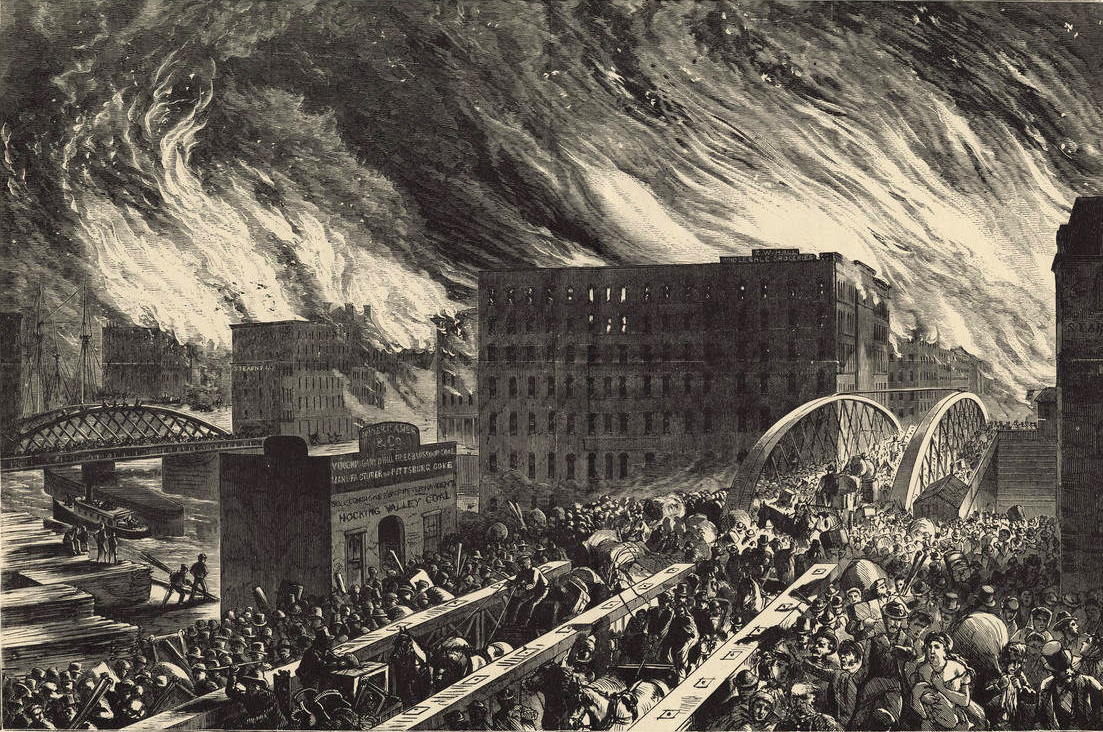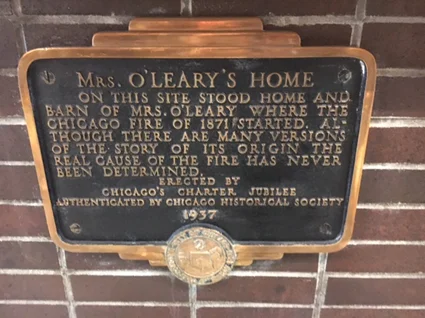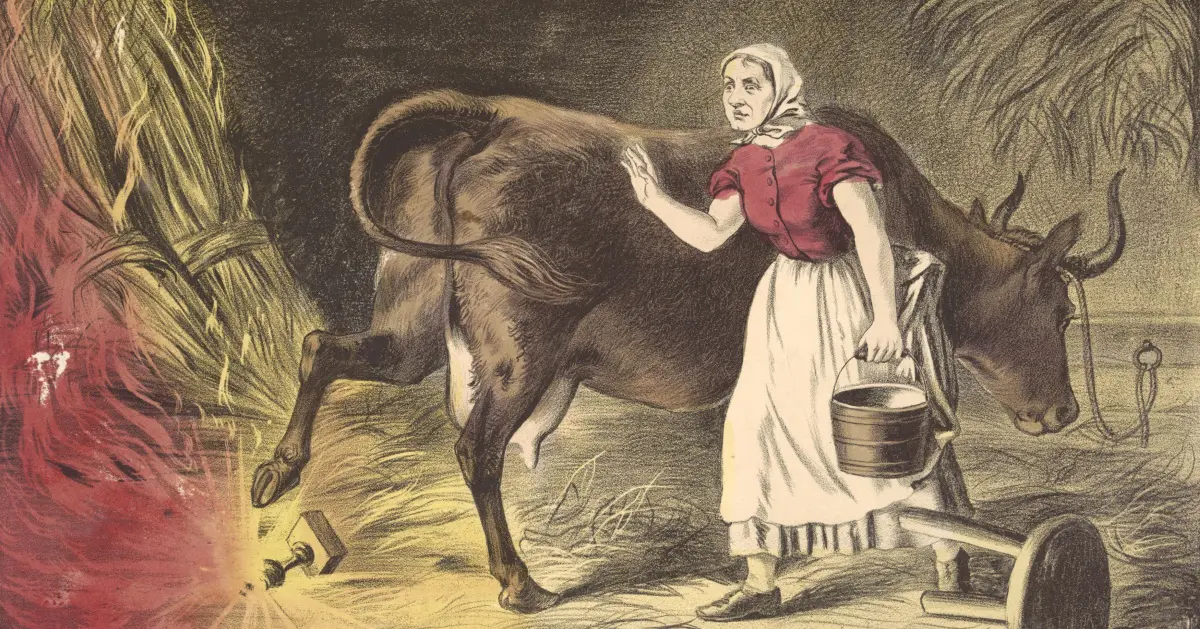A popular version says that the culprits of the Great Chicago Fire of 1871, which destroyed most of the city, were an animal and its careless owner. We checked to see if this was the case.
How They say among the people, Moscow burned down from a penny candle. In the history of Chicago, the role of the legendary candle is occupied by a kerosene lamp, or rather, the cow of local resident Mrs. O'Leary. She allegedly handled a lighting fixture carelessly on October 8, 1871, which caused fire, which forever changed the fate of not only one of the largest cities in the United States, but also urban planning in general.
Overseas, the unlucky cow and her mistress are dedicated songs, cartoons And books, and in the classic American film "In Old Chicago" (1937) follows the fascinating story of the O'Leary family since their emigration from Ireland in 1854. Already in the 19th century, this case was written about in Russia. So, he is mentioned by Konstantin Skalkovsky in his “Travel impressions in the Caucasus, Turkey, Serbian lands and the United States” (1885) and Vasily Vitkovsky in the book "Overseas: Travel Notes" (1894). The latter, in particular, wrote: “The fire was caused by some old woman who, while milking a cow in a wooden barn, carelessly knocked over a kerosene lamp. The fire burned 20,000 homes and destroyed $200 million worth of property. In terms of the number of losses, this is the worst fire in world history. Indeed, expressing all the figures in dollars, we find that the London fire of 1666 caused losses of 54 million, the fire of Moscow in 1812 destroyed property worth 150 million, the Hamburg fire of 1842 - 35 million, and even the losses of the Paris fire of 1871 from the communists are estimated at only 160 million.

Official website The Great Chicago Fire (supported by the local historical society and Northwestern University) paints the following picture of what happened.
The fire almost certainly started in the immediate vicinity of the barn where Catherine O'Leary kept five cows, which she milked twice a day to feed her five children. The family had saved enough coal, wood shavings and hay for the winter, so the fire could easily have started here. It was rumored that immediately after the fire started, Katherine confided to several people that she was in the barn when one of her cows knocked over a lantern. In a peculiar twist of fate, which did not go unnoticed by the city press, the fire spared the O'Leary family home. Several curious people claimed that they found fragments of the lantern while snooping around behind the house.
However, there are many reasons to believe that Mrs. O'Leary and her poor cow (named Daisy, Madeline, or Gwendolyn in various retellings) were innocent. Catherine O'Leary testified under oath that she was in bed when the fire started, and the official investigation found no evidence of her guilt. The stories of people who allegedly heard her “confession” were mutually contradictory. The man who many years later claimed that as a child he found a broken lantern under the floorboards of a barn could not explain how the floorboards did not burn in the inferno. As for the lamp itself, it was allegedly borrowed from the man by an Irish servant, who then disappeared. Katherine's son, Jim, grew up to become the most influential gambling boss Chicago. Over the years, in interviews, Big Jim complained that "that musty old fake about a cow knocking over a lamp makes him feel hot under the collar." He claimed that the fire was caused by spontaneous combustion of fresh hay, a large quantity of which had been delivered to the barn on the eve of the fire.
On top of that, in 1893, reporter Michael Ahearn, who was covering a fire for the Chicago Republican, admitted, that he made up details about the causes of the fire to make the story more colorful. Although in interview By 1911, he no longer spoke of himself as the source of the rumor, but he tried in every possible way to make it clear that Mrs. O'Leary was not to blame. After this, one of the reporter’s colleagues stated that it was he who, 40 years ago, sent an action-packed story to the Chicago Tribune signed by Ahearn himself.
During and after the fire, several other theories surfaced - from boys smoking to a meteorite falling. Based on the testimony, which took up a total of 1,100 pages of text, city council members issued a conclusion that read: “Whether it was a spark that flew from the chimney on that windy night or whether it was a deliberate arson, we cannot determine.” The ineffectiveness of the official investigation contributed to the proliferation of rumors, such as that the fire was started by an unnamed member of a global terrorist organization with direct ties to the Paris Commune of 1871. However, Mrs. O'Leary - Irish, Catholic, and just a woman - became an ideal target in light of the mood that reigned in the United States at that time. Reporters constantly appeared on Mrs. O'Leary's doorstep, calling her "clueless and worthless" and "a drunken old hag with dirty hands." Journalists transferred their hatred to articles where they claimed that the woman deliberately set fire to the barn, “swearing revenge on the city that denied her firewood or a pound of bacon.” Her husband set dogs on boors and threw bricks at their heads. The Greatest Showman Phineas Barnum, the creator of the circus of freaks, one day knocked on Mrs. O'Leary's door to ask her to join his tour - the woman chased him away with a broom. As the magazine notes Smithsonian, a highly dubious role in one of the greatest disasters in American history brought the woman fame she never wanted. When she died of acute pneumonia 24 years later, neighbors insisted that the true cause of her misfortune was a broken heart.
A century and a half has passed since then. On the site of O'Leary's house today there is... Chicago Fire Academy. A plaque erected here in 1937 reads: “Here stood Mrs. O'Leary's house and barn where the Great Chicago Fire began in 1871. Despite many theories, the real cause of the fire has never been determined.”

And in 1997, the municipal authorities decided to restore historical justice. The city's Police and Fire Committee voted to acquit Catherine O'Leary and her infamous cow. Based on testimony from historians and Mrs. O'Leary's great-great-granddaughter, officials came to conclusionthat the woman and the animal were unfairly slandered as accidental culprits of the fire. Instead, they argued, they should have scrutinized the actions of the woman's neighbor, Daniel (Piedfoot) Sullivan, who blamed Mrs. O'Leary for starting the fire.
Thus, despite the lack of rigorous evidence, historians are inclined to conclude that the version of the kerosene lamp knocked over by a cow is a fiction.
Most likely not true
Read on the topic:
1. Mrs. O'Leary, Cow Cleared by City Council Committee
2. What (or Who) Caused the Great Chicago Fire?
3. The O'Leary Legend
If you find a spelling or grammatical error, please let us know by highlighting the error text and clicking Ctrl+Enter.







